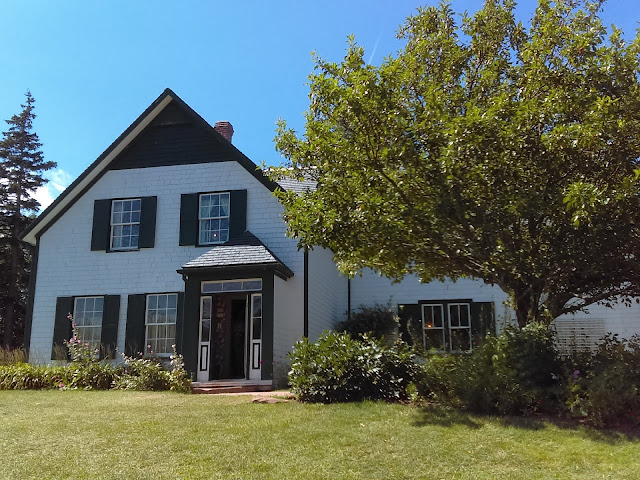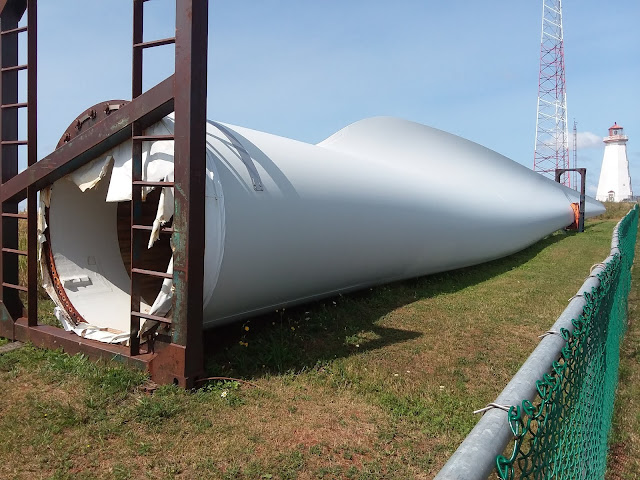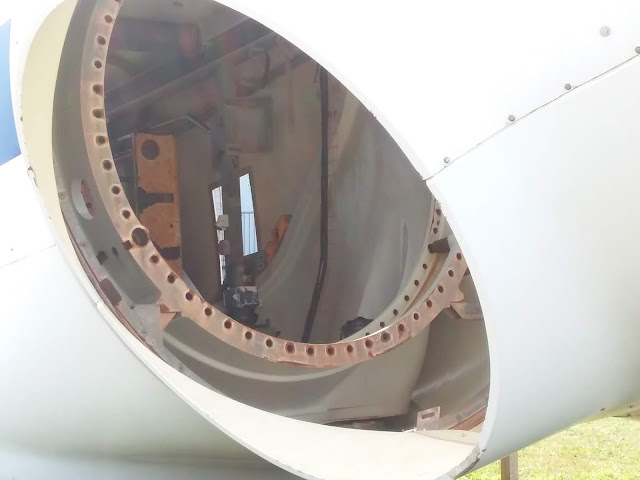Prince Edward Island - part 3
(sightseeing)
August 15, 2018 - August 18, 2018
Both locations (to follow) were photographed and written by Laura. We both really enjoyed PEI for the green and yellow rolling hills and farms! I think it had the best "feel" to it of all the other Maritime Provinces we visited (including Nova Scotia and New Brunswick).
Cavendish PEI
Who hasn't read the book or seen the movie 'Anne of Green Gables'? If you haven't, read it or watch the movie, it's very charming and you might even fall in love with Anne ("that's Anne with an e" she reminds people throughout the book). The world certainly has loved the story written by Lucy Maud Montgomery, as evidenced by the fact that it has been in publication since 1908 and has been translated into
17 languages! In Cavendish, Prince Edward Island (where the author grew up), there are two "Anne" places to see. We first visited the Museum which is the house that has been in her cousins' (the Campbell's) family since before Lucy Maud Montgomery (the author) was born and where she spent much of her childhood, playing with the cousins. The second one (a PEI National Park) is the actual house (also owned by cousins) that the story is based on (note the green gables and shutters) and where Anne, in the story, goes to live.
But first a little about the author: her mother died when she was just 21 months old but as you will read, her mother was totally charmed by her little girl. After her mom died, Maud (as she was called) went to live with her maternal grandparents because her father 'didn't know what to do with a baby' but did visit her occasionally.
 |
| Maud's parents. (Yes that's my reflection in the framed picture, sorry.) |
 |
| Lucy Maud Montgomery, born 1874 New London, PEI, here at age 6. |
 |
| This is a charming story that Maud heard from a friend of her mothers and it helped her to "know" a little about her mother. |
 |
| In a nut shell, what the story 'Anne of Green Gables' is about. |
 |
| Ewan was to become her husband in 1911. She had known him before 1906 because that was when they were engaged. |
 |
| The authors typewriter, purchased 'almost new' in 1908. |
 |
| The house that became famous in the story of Anne of Green Gables. |
 |
| The woods and hills near the Green Gables farm where Maud played and wrote about in her story of Anne. |
 |
| Her Campbell cousins' home where she visited often, because as seen below, she had her own bedroom there. The house is now a museum and still owned by the Campbells. |
 |
| Maud had a real love for this home as shown on the sign. |
 |
| L. M. Montgomery's "own little bedroom" in the Campbell home. |
 |
| There is an old photo of this bedroom on the wall when she stayed there and the room looks the same today. |
 |
| This china cabinet was in the Campbell home and as a child, Maud would see her reflection in the two windows and pretend they were little girls that were her friends. Below explains what she imagined. (One of my nieces had an imaginary spider when she was little so I didn't think this story unusual at all!) |
 |
| (The Alpine Path was an autobiography of the author, Lucy Maud Montgomery.) |
 |
| Reverend Ewan Macdonald 1906, the year of the engagement to Maud Montgomery. |
 |
| 1911 the year Maud married Ewan, she was 36, they moved to Ontario, Canada. |
 |
| Montgomery wrote about 22 books and these drawings show where, on the island, the some of the stories "took place". She loved Prince Edward Island where she was born and raised and would visit (from her home in Ontario) as often as she could. |
 |
| Lucy Maud Montgomery, taken in 1935, 7 years before her death at age 67. |
 |
| While at the Museum (Campbell house), we discovered that the Green Gables story was very popular in Japan! As we waited for the explanation of the house, a Japanese family came in and since one of the cashiers/docents was Japanese, she explained some things to them in their language. After touring the home, we were sad to have to leave as it had such a nice homey feel to it. There were original copies of the books in a couple rooms and one on the bookcase shelf (see bookcase, above a few pictures) and current copies of Maud's books for sale in the gift store. I hope you have enjoyed the story as much as we did, I had no idea she had written so many sequels and other stories as well. I'm going to have to read some of them to find out just what happened to Anne as she grew up! |
The Glass Bottle Houses in Cap Egmont were very unique! We had heard about them from friends and just had to see them!
 |
| This is the first building Edouard Arsenault made (see next picture for details). Isn't it cool? |
 |
| Just think how long it would take to collect 12,000 bottles!! As soon as people in the area heard about his endeavor's they started collecting bottles and dropping them off for his house. Notice where Edouard first got the idea to build a bottle house - in British Columbia. Well, we saw that bottle house back in the 1980's and it is made of bottles from embalming fluid! Yep, you heard me right, it was kinda creepy to think about how many bodies had to be buried to have that many bottles! |
 |
| The inside of the first house and a photo of the builder when he was much younger. |
 |
| The back door of the first bottle house. Wouldn't it be fun to see the sun shining through the many colored bottles as it rose over the horizon in the morning? |
 |
| A few pretty day lilies and liatrus along with some petunias and other flowers against the first house. |
 |
| Even though this wasn't the first (or second) building built, it was the first building we saw and is a church! I don't recall ever seeing an explanation of when he built this church but it must've been after houses 1 and 2. |
 |
| Complete with alter and "stained" glass window (colored bottles - of course!). |
 |
And very hard pews! But probably the most unusual church you'd ever see.
 |
| I liked the entrance on this second house. It looked more like a regular house might look. |
|
 |
| The gardens were fantastic! I did take lot's of pictures of the flowers but since I'm supposed to keep the blog shortish, I didn't add any to this blog about the houses, sorry. Hope you enjoyed these houses, don't think I'd want to live in any though. |
As we crossed over to Prince Edward Island we both immediately noticed the rural character of the area. Although we occasionally saw farm fields in both Nova Scotia and New Brunswick there was no comparison to the vast number of beautiful rolling farm fields in central Prince Edward Island. Potatoes are the main commercial crop here and we saw lots of signs offering new potatoes for sale alongside the road. The pictures below really don't do the area justice but you'll get the idea. Another pleasant surprise were the roads. They were the best of anywhere we've traveled in the Maritimes. There are lots of asphalt patches but they actually appear to be done with care and pride. And, they are actually smoothed out to match the surface to ensure as smooth a ride as possible. I really must send their road department a letter noting their good work and perhaps one to the road departments in Nova Scotia and New Brunswick suggesting they get some training from the guys in PEI.



As in the other provinces, there are so many pretty views everywhere you look. With the ocean all around there's a water view somewhere.
In the town of Miscouche we noticed an Acadian museum which looked interesting. The experience the Acadians living on PEI had was somewhat different than those living in Nova Scotia because Prince Edward Island (then called Isle Saint-Jean) and Cape Breton Island (then called Isle Royale) belonged to France longer than the area now known as Nova Scotia and New Brunswick.
The first French colony on Isle Saint-Jean (PEI) was established in 1720.
 |
| Just as they did in the Grand Pre area of Nova Scotia, the Acadians resorted to dyking areas to create farmland. |
 |
| The deportations from PEI took away three fifth's of the island's population. Some escaped deportation by moving to the mainland, especially to Quebec while other went into hiding both on the island and in the areas of Nova Scotia and New Brunswick. |
 |
Just as in Nova Scotia, some of the Acadians returned to the areas where they had once lived.
The island was now under British rule so the Acadians were forced to work as tenant farmers under British landlords. |
 |
Land ownership has always been a big force, pulling people to the New World, and it was no different for the Acadians.
It took time and often several moves before they were finally able to own their own land. |
 |
| They returned to farming as their main livelihood but still fished to supplement their income. Some also became boat builders, navigators, lumberjacks, sea captains, etc. |
 |
| As Catholics, the church was always an important part of their lives. |
 |
For many reasons, not the least of which was their religion and language,
the Acadians kept to themselves forming a closed society.
|
 |
| A call to "rise up" against the English. |
 |
As so often happens young Acadians moved away from the areas where they grew up.
They sought jobs in the industrial cities of New Enland. |
 |
The fight to maintain their heritage was fought for years.
Not until 2000 did they win the right to have access to a French language school in their communities. |
For my genealogical friends who may have Acadian ancestry, the following pictures show the most common surnames in the Acadian communities on Prince Edward Island.
 |
| The Acadian flag is basically a French flag with a gold star in the upper portion of the blue stripe. |






















































































